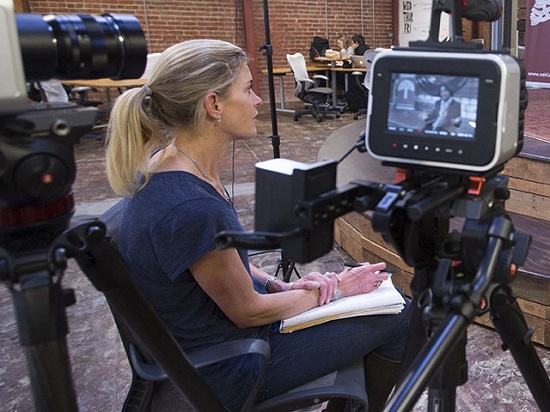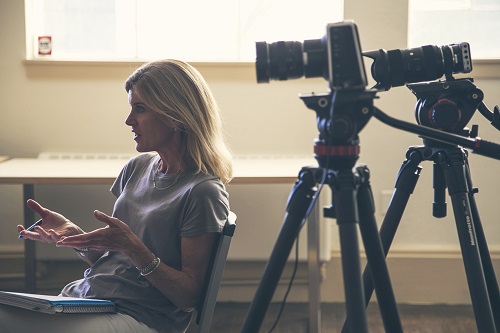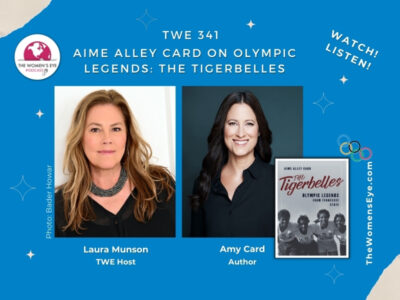
By Patricia Caso/Sept. 21, 2015
I am constantly amazed at the enormous strides made in science, technology, engineering and math. And yet, as some of TWE’s interviews showcase, STEM jobs and opportunities seem to elude young women and people of color.
I just saw the documentary CODE: Debugging the Gender Gap by award-winning documentary film director Robin Hauser Reynolds (@Rubie226) that not only illustrates the reasons for this disparity but initiates ideas to resolve job parity by employing the very people who are left out.
“I am interested in making films of compelling stories. I am very driven by cause-based films, the ones that can help make change.” Robin Hauser Reynolds
I was very excited to catch up with Robin to find out how and why she decided to explore this inequality…
EYE: What triggered your interest in taking on coding and the gender gap for your documentary?

ROBIN: My daughter was in a computer science major doing very well, actually. Yet, she doubted her ability to be successful.
She had the impression she was failing. It was shocking to me. Her professor told her she was in the top third of her class, which was a second level in computer science.
Then at the third level, it was assumed that she would partner up with the only other woman in the class and they were ignored by many of the others. Additionally, there was the perception that everyone knew more than she did. She just really hated the situation and it deterred her.
Robin speaks at inspirefest 2015 about the diversity gap/siliconrepublic
EYE: You found out through your research that your daughter was not alone in her perceptions. In fact, gender parity for STEM opportunities is actually a part of several issues that concerned you.
ROBIN: Yes. At the same time that my daughter was having her doubts, there were international newspapers coming across my doorstep claiming that if you wanted to get a good job out of college, you really should study computer science. There were a record number of job opportunities in computer science.
The White House issued a report that by 2020, there will be 1.4 million computer science related jobs and only 400,000 computer scientists in the United States. So there will be a million unfilled jobs.
“I just couldn’t understand why we weren’t doing more to try to educate and nurture our students, particularly women, in this field. I thought this was just not a social issue or gender parity issue, but it’s an economic issue. I began to look into the reasons for it.”
EYE: Why did you think making a film would make an impact?
ROBIN: First of all, I am a visual person and a creative person. I love putting things on film. I’m driven by curiosity. I want to know why something is the way it is.
In CODE: Debugging the Gender Gap, I was really curious about why a gender gap is happening. I did not approach it with an agenda. I approached it with a curiosity to try and figure it out, look at it objectively and try to understand it from the male perspective, the female perspective and from the industry perspective.
I am not interested in making whiny female films. I am interested in making films of compelling stories. I am very driven by cause-based films, the ones that can help make change.
Trailer for CODE: Debugging the Gender Gap/Ambulante California 2015
EYE: Why aren’t more women and people of color getting into computer science?
ROBIN: I believe our biggest deterrent is the stereotype we have of what a computer scientist looks like and is. Next, myths that coding is boring, technical, unsocial and not useful need to be debunked.
Coding is a discipline and it can also be very imaginative, creative and quite collaborative. People, more and more now, are coding and also designing products.
In the movie we used Danielle Feinberg, who is making films at Pixar, showing how she and her team used code to design the way light shines off a school of fish in Finding Nemo.

Code is important in designing fashion; it’s in our car navigation systems; it’s in hospitals. Really, it’s a basic in almost everything we do.
EYE: How do you start breaking down the barriers, these stereotypes?
ROBIN: First of all, we have to have more female role models. I think it is very important that we need more people than the average white or Asian 25-year-old male to stand out in STEM, particularly computer science.
The more women come forward as role models, in important scientific roles, in politics, in films, books, television, etc., the more that women and people of color can believe they can become that.
EYE: You say in your documentary that anyone can code. Is that really true?
ROBIN: That’s right. Anybody who puts her or his mind to learning computer science and has an interest in computer science can learn it. We looked at whether or not there is an innate difference between a man’s brain and woman’s brain to see if one can learn or do coding better than another.
“There are some people who believe that a man’s mind is better at coding. We learned it is not true.”
EYE: What do you want to say in your documentary?
ROBIN: We want to change the stereotype of the programmer, the way women and people of color see themselves in the industry, and ultimately to get the audience to reflect. Whether you are a young woman or a male coder, consider your own biases, which we all have, and think about how to help rectify the situation.
We know that adding a woman to a team increases productivity and the overall IQ of the team goes up, regardless of her IQ. It’s not just about filling jobs; it’s also about how diversity adds to innovation.

EYE: How does diversity help innovation?
ROBIN: Consider these examples. How is a group of 27-year-old males who grew up in the same upper socioeconomic area going to know that there is a really desperate need for some people who need clean drinking water?
How are they going to understand that young women might need an instruct-able app to store breast milk? Can they understand kids in the underserved cities who don’t have money for the internet and cannot even get their homework done?
It is those people ‘outside that socioeconomic group’ whose input and imagination can create opportunities for situations like these. So, it takes socioeconomic diversity, gender diversity and ethnic diversity to understand the needs and the solutions.

EYE: Why are companies slow to see the plusses of diversity?
ROBIN: In the case of startup companies, I think they are thinking about scrambling and keeping up with the demand and excitement of the new project or whatever they are building.
The fraternity boy mentality is something that really needs to change. I am actually quite shocked at the amount of sexism in startups among 20 and 30-year-olds.
I asked a group of engineers how many of them had daughters? Maybe half the room raised their hands. When I asked them how many of them would be comfortable with their daughters in their work environment, the hands went down. They realize how difficult an environment it is for women.

EYE: What can companies start doing now to improve inclusion of women and people of color in engineering?
ROBIN: Very few companies have more than 18% women engineers. Etsy and Indiegogo have done a good job. More need to follow. Companies can do three things: (1) Hire women for merit (2) Promote women, (3) Pay women. And, pay them equally. Just by doing that will get women in leadership positions.
“The more women in leadership positions, the more women will be hired in the company and there will be more role models for those young people to come!”
EYE: Were you changed by doing this documentary?
ROBIN: I used to shy away from the word “feminism” before. I think I used to think there were some negative connotations to the word. I’m now proud. I know now lots of men whom I highly respect who proudly call themselves feminists. It’s a strong, powerful word and a positive thing for all.
I’ve been in male-dominated careers in most of my professional life as a stockbroker and now in the film world where less than 6% of women are directors. I’d have to say that most of the time when faced with sexism, I’ve put blinders on and charge ahead and don’t let it bother me.
Robin discusses her documentary, CODE, at SXSW/2015
EYE: What advice do you have for young women coming up through the ranks facing sexism who may not be as confident as you?
ROBIN: I think the one thing we can do for our daughters, our granddaughters, our nieces, our sisters, etc., is to instill an enormous amount of confidence in them. They need to know that they can do anything they want if they put their mind to it. Nothing should stand in their way.
I think women that don’t naturally have that need to find mentors and sponsors will be honest with them in a true way. And in some cases, you need a thick skin. I also think men and women need a sense of humor.
EYE: Is there anyone that inspires you?
ROBIN: Gloria Steinem, of course. I met her ever so briefly when I was in TriBeca, and I would love to have a conversation with her. She is a beautiful, strong intelligent woman.
I love the fact that she is also brave. She is so un-bashful about standing up for women’s rights. She’s never been afraid to be vocal about being a feminist and standing up for women’s rights.
EYE: Do you see yourself as a trailblazer for women?
ROBIN: I am totally humbled and grateful if in making CODE or speaking to groups that I have been able to help inspire some women. It took an amazing team to produce this project. I am not alone. And, I don’t see myself being done with the challenge of showcasing other people and causes anytime soon!
EYE: Having previewed CODE, I encourage our readers to go to this CODE documentary link to find a screening. Men and women of all ages will be intrigued. Thank you, Robin, for your time, insights and we look forward to your next project!
###




Leave a Reply